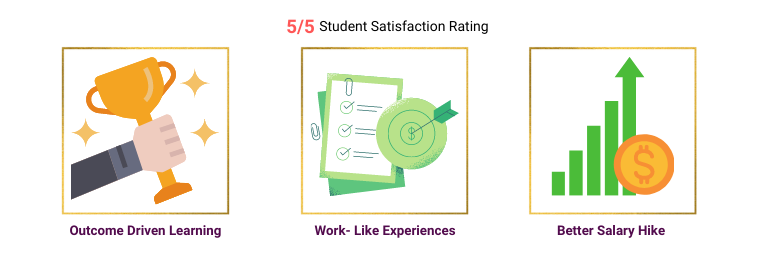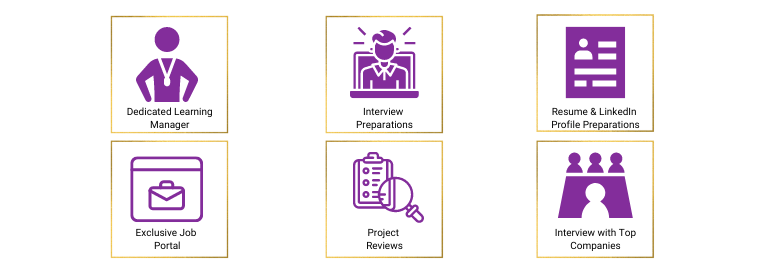Certified Scrum Master (CSM )® Online Training
CSM Training in India offered by Mentors Pool is designed to offer a detailed overview of the Scrum framework. The Certified Scrum Master can handle Agile Project Management in a well-versed manner as the CSM Certification course deep dives into all scrum concepts with examples. The Scrum Master Certification course is a two-day training covering all Scrum methodologies and their implementation which widely opens the career horizon in several business models.
In collaboration with
Online Class
Projects
Hands-On
n/a

20 Hrs Instructor-led Training
Mock Interview Session
Project Work & Exercises
Flexible Schedule
24 x 7 Lifetime Support & Access
Certification and Job Assistance



Course Benefits




Certified Scrum Master (CSM )® Certification Training Course Overview
1. Learn Fundamentals
Understand the foundation of Agile and Scrum concepts and help Scrum teams in using Scrum effectively.
2. Terminologies and Concepts
Acquire knowledge of Scrum terminologies, various concepts, and the complete Scrum process.
3. Scrum Roles
Understand various roles involved in Scrum and the scope of the Scrum Master role in Scrum.
4. Core Competencies
Learn key Scrum Master core competencies and protect the team from internal and external distractions.
5. Scrum Ceremonies
Daily Scrum, Sprint Review, Sprint Retrospective, Product Backlog, Sprint Backlog, Definition of Done.
6. Facilitate Teams
Facilitate the Development Team, Product Owner, and the organization while responding to change.
7. Improve Transparency
Inspect and adapt and increase transparency in each of the Scrum events and make the team’s work visible.
8. Acts as a Servant Leader
Learn to help the team members work collaboratively and follow every Scrum process involved in it.
- Software Engineers
- Product Managers
- Team Leaders
- Business Analysts
- Development team members
- Testers
- Anyone who would like to build a career as a Scrum Master
There is no set of eligibility requirements to attend this Scrum Master Certification course and it can be taken by freshers or professionals who want to:
- Further their career in project management.
- Deepen their understanding of Scrum.
Mentors Pool follows a rigorous certification process. To become a certified Scrum Master (CSM), you must fulfill the following criteria:
- Online Instructor-led Course:
- Successful completion of all projects, which will be evaluated by trainers
- Scoring a minimum of 60 percent in the certified Scrum Master (CSM) quiz conducted by Mentors Pool
Today, most of the IT as well as non-IT industry majors are hiring candidates who are familiar with the Scrum framework. A Certified ScrumMaster® can upscale an organization in the following ways:
- Guide team members through the product development
- Help the team deliver quality products
- Participate in the team activities with ease and also learn how to own a task
- Resolve the impediments and enhance the team’s collaboration
- Act as a change agent and enable a culture in which teams can flourish
- Become a servant leader for Scrum teams that are involved in developing high-end products
Talk to Us
IN: +91-8197658094
As a Certified ScrumMaster, you will be known as being part of an elite group engaged with Scrum Alliance. The members of Scrum Alliance are meant to be Scrum specialists, guiding the project teams to success. Here is why CSM® certification should be a part of your skill set:
- Based on the recent salary survey by Ziprecruiter, the average annual salary for the Certified ScrumMaster is $116,659 a year.
- CSM® certification enables you to work across major companies like IBM, Tata Consultancy Services, CapGemini, Honeywell, BOSCH, Accenture, Deloitte and many more in several job roles.
Fees
Online Classroom
- 20 Hrs of Instructor-led Training
- 1:1 Doubt Resolution Sessions
- Attend as many batches for Lifetime
- Flexible Schedule
Batches
Dates
Days
Timings
Enrolment validity: Lifetime
Login
EMI Option Available with different credit cards
Cart
Corporate Training
- Customised Learning
- Enterprise grade learning management system (LMS)
- 24x7 Support
- Enterprise grade reporting
Course Content
Certified Scrum Master (CSM )® Certification Training Course Content
Get familiar with the 12 principles and 4 values stated in the Agile Manifesto through our popular in-class activity- “Draw and demonstrate”. Herein, you will be asked to form groups and illustrate all 12 principles pictorially.
What you will learn
At the end of this activity, you will be able to-
- Explain the 12 principles and 4 values listed in the Agile Manifesto.
- Demonstrate the benefits of “responding to change” in Agile over “following a plan” in traditional project management.
- Describe how the Scrum values (courage, focus, commitment, respect, openness) relate to the Scrum artifacts, events, and roles.
- List and explain the three pillars in Scrum ― Transparency, Inspection, Adaptation.
- Explain the differences between framework and methodology and understand why Scrum is called a framework.
- List 5 ways to develop an Agile mindset.
- Illustrate 2 differences between Agile and Scrum and explain why these two terms cannot be used interchangeably.
Topics covered
- Agile Manifesto
- 12 Principles
- 4 values
- Scrum Foundations (5 Scrum Values)
Learn more about the three roles in Scrum with role-based activities. Each group will play a simulation game called “candy catch” that will have three iterations. The Scrum Master and Product Owner (chosen by group members) will coordinate and help the team achieve the highest target within the shortest time.
What you will learn
At the end of this activity, you will be able to-
- Conduct a retrospective to list 3 techniques to improve the performance and turnaround time.
- Explain the roles and responsibilities of a Scrum Master and a Product Owner.
- List 3 differences between a Scrum Master and a Product Owner and understand why these two roles should not overlap.
- Discuss how a product owner acts as a bridge between the development team and the stakeholders.
- Understand why a Scrum Master is not an active participant but a facilitator in the Scrum events and ceremonies.
- List 3 demerits of having a development team of less than 3 members or greater than 10 members.
Topics covered
- Scrum Master roles and challenges
- Product Owner roles and responsibilities
- Development team roles and responsibilities
Take part in the Scrum Paper Plane game and learn how the 5 Scrum ceremonies work. There will be 3 sprints, each lasting 15 minutes. You need to prepare the user stories that will cover the features and functionalities along with acceptance criteria.
What you will learn
At the end of this activity, you will be able to-
- Explain the “why” and “how” of sprint planning, daily scrum, sprint review, and retrospective.
- Understand why the scope and duration of a sprint are fixed.
- List 3 ways to avoid sprint backlog spillover.
- Define sprint goals and discuss 5 benefits of having a sprint goal.
- Understand how the Scrum Master and the Product Owner should coordinate with the team and list 5 points to improve such communications.
- Discuss 3 damaging impacts of sprint cancellation and how to avoid it.
- List 10 sprint anti-patterns (E.g. sprint cancellation, variable sprint length) and understand how these impact the delivery and turnaround time.
Topics covered
- Sprint planning
- Daily Scrum
- Sprint Review
- Sprint Retrospective
Experience how scrum works in real projects with our simulation game “Crime Teller”. The activity will be divided into 3 sprints, wherein the participants will actively employ Product backlog refinement among other scrum artifacts to solve a given “crime” story.
What you will learn
At the end of this activity, you will be able to-
- List and demonstrate 5 salient features of a well-formed product backlog (E.g. estimated, prioritized).
- Discuss 2 responsibilities of the Product Owner, Scrum Master, and the Development team in creating and maintaining a product backlog.
- The objective of having a product backlog and best approaches to product backlog refinement.
- Analyze and discuss the ideal time and capacity to be dedicated to product backlog refinement.
- Demonstrate 3 activities (E.g. budget and timeline, release schedule) that take place during a sprint review.
- List 5 sprint review anti-patterns (E.g. delayed acceptance) and their negative impacts
Topics covered
- Product Backlog
- Sprint Backlog
- Product Increment
Learn about Scrum life cycle by taking part in the “coin game”. The participants will be linking ceremonies to create effective sprint goals. This module will focus on the common challenges in sprint execution and enable team members to improvise.
What you will learn
At the end of this activity, you will be able to-
- Explain the difference between resolution meetings and daily standups.
- Explain the benefits of collaborations with product owners.
- List 3 demerits of over collaboration of the product owners.
- Demonstrate 3 ways to break the barriers and collaborate
- Demonstrate creation of sprint burndown chart
- Explain 3 approaches to increase efficiency in the team
Topics covered
- Sprint Execution Planning
- Flow management
- Resolution meetings
- Communication (Taskboard, Sprint burndown chart using story points, hours effort)
Play the “Marshmellow Tower” game and learn more about daily scrum and sprint retrospective in real scrum projects. The tallest tower built with the minimum raw materials and in the shortest time frame will win. Acceptance criteria will be defined by the instructor.
What you will learn
At the end of this activity, you will be able to-
- Explain the importance of 15-minute timebox for daily scrum meetings.
- List 3 differences between traditional meetings and daily stand-ups.
- Describe 2 roles played by the Scrum Master, Product Owner, and the Development team in daily scrum.
- List the 3 critical questions pertaining to the daily scrum agenda.
- List 2 responsibilities of the Scrum Master, Product Owner, and the Development team during the sprint retrospective.
Topics covered
- Activities in daily scrum
- Activities in sprint retrospective
Familiarise yourself with Definition of Done (DoD) and Acceptance Criteria with the “Crazy Juggler” game wherein you need to pass a fixed number of balls to non-adjacent team members within a certain time frame and collect them in a paper bag once marked as “done”.
What you will learn
At the end of this activity, you will be able to-
- Explain Definition of Done at three levels ― user story (e.g. writing code), sprint, and release (e.g. preparing release notes).
- List 3 benefits of Definition of Done and explain why it can evolve over a certain period of time.
- Prepare a checklist (with a minimum of 7 entries) of an ideal DoD.
- Mention 3 risks associated with an ill-formed DoD.
- List 5 characteristics of good acceptance criteria.
- Understand who all should be involved in drafting the acceptance criteria.
- List 3 negative impacts of not following the acceptance criteria.
Topics covered
- Definition of Done for a feature (user story or product backlog item)
- Definition of Done for a sprint
- Definition of Done for a release
- Definition of Done vs. Acceptance criteria
- Done vs. Done-Done.
Acquaint yourself with the Definition of Ready with our Lego blocks game wherein the attendees will be asked to build a city out of Lego building blocks. The “definition of ready” checklist for the final deliverable will be determined by the instructor.
What you will learn
At the end of this activity, you will be able to-
- Create an ultimate checklist of Definition of Done.
- List 3 negative impacts of an ill-formed Definition of Done.
- Identify at least 3 benefits of a shared Definition of Done for multiple teams working on the same product backlog.
- List 2 ways to improve Definition of Done.
- Clearly understand the differences between “done” and “done done”.
Topics covered
- Definition of Ready for user story
- Definition of Ready for sprint
Play the self-organization game “Human Knots” by forming teams of 5-6. Groups where team members can untie themselves first win. The time frame for this activity will be decided by your instructor. Each team will have a Scrum Master and Product Owner chosen by group members.
What you will learn
At the end of this activity, you will be able to-
- Define and understand the steps involved in release planning.
- List 3 benefits of a well-organized release planning.
- List 3 outputs of release planning.
Topics covered
- Definition of release planning
- Who takes part in release planning
- Steps in Release planning
- Output of Release Planning
Acquaint yourself with the Sprint Burndown Chart concepts by taking part in the ball point game. There will be 5 iterations and the number of points being expected at the end of the release will be communicated to the team.
What you will learn
At the end of this activity, you will be able to-
- Define and understand sprint burndown chart.
- List 3 primary reasons to use a burndown chart.
- Learn how to create and calculate a burndown chart.
- Explain how to adjust upcoming sprints based on the burndown.
- List 3 critical information obtained from a burndown chart.
- List 5 merits and 2 demerits of using a burndown chart.
- Understand 5 common errors that lead to misleading information in burndown charts.
Topics covered
- Definition
- Why and when to use a sprint burndown chart
- Information obtained from sprint burndown chart
Take part in the ball point game and understand the in-depth concepts of release burn-up charts and why Scrum teams use them. There will be 5 iterations and once the sprint is completed, the team will put a mark on the release burn-up as to how many points are completed.
What you will learn
At the end of this activity, you will be able to-
- Understand the importance of having a release goal (based on historical data and agreement).
- Demonstrate the importance of release burn-up in understanding the current status.
- List 2 differences between burndown and burn-up charts.
- Explain how to adjust release planning (if needed) based on the burn down.
- Tell one primary advantage of a burnup chart over a burndown chart.
Topics covered
- Definition
- Features
- How to create a release burn-up chart (steps)
Topics covered
- What is product planning
- What is product vision
- How to create a product backlog
- Product Roadmap
- Minimum Releasable features (or) Minimum Marketable Features
- Minimum Viable Products
Be a part of the Lego Building Blocks game wherein participants will be asked to write user stories for every activity involved. The game will entail 3 iterations and attendees will prepare user stories that will cover the features and functionalities along with acceptance criteria.
What you will learn
At the end of this activity, you will be able to-
- Define and explain user stories and understand the importance of user stories in real-time projects.
- Explain the 3 Cs in user stories.
- Discuss the importance of acceptance criteria and list 3 scenarios that might arise when the acceptance criteria are not met.
Topics covered
- What are user stories?
- Structure/format of user stories
- INVEST criteria
Learn more about the “what” and “how” of Agile estimation with our in-class Agile board game “Scrumble”. In an interactive setting, this game will let you analyze the common challenges faced by Scrum team members during implementing different estimation techniques in Agile.
What you will learn
At the end of this activity, you will be able to-
- List and demonstrate 5 benefits of Agile estimation.
- Understand the 7 popular Agile estimation techniques and decide which one is the best for your project.
- Discuss 3 benefits of Relative Estimation and Planning Poker.
- List and explain 3 common mistakes made while using Relative Estimation and their negative impacts.
- Discuss in detail the 5 critical steps in Planning Poker.
Topics covered
- Definition
- Benefits of Agile Estimation
- Agile estimation techniques
Know everything about planning poker from our popular poker card estimation game. Team members/estimators have to privately select one card and the value on each card would represent the story point. Once all cards are revealed, the values need to be discussed.
What you will learn
At the end of this activity, you will be able to-
- List 5 benefits of planning poker estimation technique.
- Decide the best sequence for the values (story points) on cards for your real-time projects.
- Discuss in detail the 5 critical steps in Planning Poker.
- List 3 points to heed for employing planning poker for distributed teams.
Topics covered
- Definition
- Benefits
- Participants
- How to play planning poker
- Planning Poker rules
Course Projects
Effective Practices and Federal challenges in Applying Agile Methods
The Government Accountability Office (GAO) Provides a review of the challenges and success factor for Agile projects within the federal government based on their investigation of four successful programs.
Borland's Agile Journey :A case study in Enterprise Transformation
In this 2009 case study, the vice president of Product Development at Borland talks about benefits they received and the key lesson learned in their three-year journey to apply Scrum to their business.
Moving Back to Scrum and Scaling to Scrum of Scrum in Less than a Year
This fifteen - minutes video presentation explains how one Brazilian company struggled with scrum, failed and then eventually succeeded.
Course Certification
A Certified ScrumMaster® is a professional designated by Scrum Alliance as a Scrum practitioner who can skillfully lead project teams. A Scrum Master is not a project leader or project manager but instead, a Servant Leader who assists the team to succeed with the Scrum framework.
The exponential growth of Scrum, combined with the rising Scrum adoption in 65% of IT enterprises globally indicates the need for Certified ScrumMasters who can facilitate complex project execution. A CSM certification from any Global REP (Registered Education Provider) helps reinforce your industry identity as an Agilist who can lead projects to successful execution.
A CSM certification will prove to the companies that you have the required skills needed for working in a Scrum team as Scrum Master or team member. Here are some benefits of getting CSM-certified:
- Expand your knowledge and overcome obstacles while being part of a Scrum team, especially when you are managing teams across multiple departments.
- Improves team collaboration and management.
- Get ahead in the field by becoming a better competitor and staying relevant.
Here are three steps you need to complete to apply for the CSM certification:
- Get an understanding of Scrum and make sure that you complete all the prerequisites for the CSM course.
- Attend the 2-day in-person CSM course led by a Certified Scrum Trainer.
- Apply for the exam.
Before you attend the CSM course, you have to familiarize yourself with the theory and principles of Scrum. It is important to read the official Scrum Guide and study the Agile Manifesto. A CSM course usually starts with a short quiz to check if you are ready to begin the training. To pass this quiz, you must know about the Scrum theory, roles, events, and artifacts.
After getting your CSM certification, you can go to the next level. Here are some certification examples you can go for:
- Advanced Certified Scrum MasterSM (A-CSM SM)
- CSPO®
- ICP-ATF (Agile Team Facilitator)
- ICP-ACC (Agile coaching)
- KMP
- PMP® certification
- PMI-ACP® Certification
- SAFe® Agilist
- SAFe®- SASM
Certification Course Reviews
Certification Course FAQs
Step 1: Take the 2-day CSM® course from the Global Registered Education Provider of Scrum Alliance.
Step 2: Scrum Alliance will send you a welcome email containing a link after successful completion of course.
Step 3: Click on the link received from Scrum Alliance and activate your Scrum Alliance® certification account where you will be able to complete the CSM test.
Step 4: Take the 1-hour online CSM® test which comprises of 50 MCQs by using those credentials.
Step 5: : After successful completion of the course you can take the exam, the passing score for which is 74%.
Step 6: Once the test is completed with the minimum passing score, you will be requested to accept a license agreement.
Step 7: After accepting it, you will receive Certified ScrumMaster® (CSM®) designation from Scrum Alliance and a 2-year membership with Scrum Alliance as well.
Step 8: If your certification has expired then you need to renew it. It must be renewed once in two years.
The most important skills that every Scrum Master should have are as follows:
- Systems Thinking: This skill helps the Scrum Master to build a comprehensive perspective towards the whole organization as a system.
- Facilitation ability: The Scrum Master facilitates the Scrum events for the team members to reach a high-end decision.
- Complex Problem Solving: The Scrum Master will be able to handle various complex situations while undertaking product development.
- Coaching: Team members need someone to guide and coach them to follow Scrum principles properly, which the Scrum Master does.
Not just software companies but many other industries are looking for Scrum Masters to improve their organizational processes. Here is the list of top industries and companies that have hired Certified Scrum Masters:
Information Technology:
- Philips
- Dell
- Honeywell
- Allstate India
- Goldman Sachs
- Siemens
- Informatica
- Capgemini
- Intel
- Zensar Technologies
- Accenture
- Vodafone India Services Private Limited
- Techstar Software Development India Pvt
- Nokia Siemens Networks Ltd
- France Telecom
- NewWave Telecom & Technologies
- ENGIE Insight
- Rockwell Automation
- Synacor
- Frontier Communications Corporation
- First Tech Federal Credit Union
- Applied Materials India Private Limited
- Applied Materials
- Johnson Controls
Agile refers to a mindset on how to approach software development. Scrum is the most widely used Agile framework, amongst others such as Kanban and Extreme Programming.The term Agile was coined in 2001 when the “Manifesto for Agile Software Development” was created. The authors were the two creators of the Scrum famework, together with 15 others who had a similar mindset on how to approach software development. The manifesto stresses the need to deliver software that customers value early and continuously during development. This way, that what is delivered can be changed rapidly during development, based on customer feedback. To make this possible, close collaboration is needed between developers amongst each other, and with their clients.
Scrum provides a structure on how to work from an Agile mindset. While originating from software development, Scrum is defined in a more generic manner. It is also applied in other domains than software, such as marketing. The framework helps a self-organizing team to get things done frequently and in close collaboration. There will be many opportunities during development to inspect what has been delivered so far, and to improve the way the work is conducted.
|
Tool Name |
Features |
Cost |
|
Jira |
The most popular and widely used cloud and subscription-based software for Agile teams. |
$10/month for up to 10 users $7/month for 11-100 users |
|
Vivify Scrum |
A well-balanced tool with an appealing UI and useful Scrum features. |
Offers free version for 14-days $8/user/month |
|
ScrumDO |
This is the tool built and priced to scale your Agile projects. |
$8.99/month for up to 10 users |
|
Manuscript |
A new tool built for the real-world barriers that exist in a software development environment. |
$62/month for 5 users |
|
Axosoft |
This scrum tool offers organization and structure to many components of Scrum project management. |
$25/month for 5 users |
|
Targetprocess |
This Scrum tool enables software development teams to speed up product delivery at all levels of the organization. |
Offers free Team version $20/user/month |
|
Yodiz |
It offers a greater degree of visibility into your team’s progress and increases overall efficiency. |
Offers free version for up to 3 users $3/user/month |
|
Quickscrum |
This Scrum tool helps your team to collaborate better, reach goals, and improve continuously. |
$3/user/month |
|
Scrumwise |
It allows you to focus on your project, improve communication, enhance teamwork and gives you faster results. |
$7.50/user/month |
|
ScrumDesk |
Designed for teams implementing Scrum or Kanban and supports Agile practices like root cause analysis or retrospectives. |
Free for up to 4 users $9/month for up to 5 users |
|
ClickUp |
It helps to make projects more productive with a well-designed and intuitive platform. |
$5/user/month |
|
Zoho Sprints |
A tool that helps Agile teams plan and track their work. |
Offered as a free tool for up to 3 users and 2 projects $8.30/user/month for up to 10 users |
The CSM certification is valid for only 2 years. During this period, you need to get the requisite credits to maintain the certificate. You will need to submit a predetermined number of Scrum Education Units (SEUs) along with a renewal fee, in order to maintain the certification for a further period of two years.






